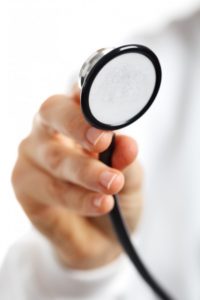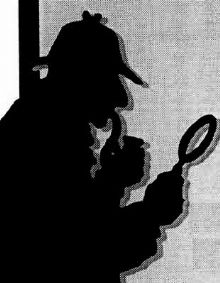Over the next few Medical Mondays, we’re going to talk about how your doctor reaches a diagnosis of common conditions associated with coagulation. We’ll be covering
- Introduction
- DVT, Deep Vein Thrombosis
- Post-thrombotic syndrome
- PE, Pulmonary Embolism
- Pulmonary hypertension
- AF, Atrial Fibrillation
- Heart Valve conditions – aortic and mitral
- Thrombophilia
- Stroke
- Heart attack
Today we’ll start with an overview of how doctors are trained to reach any diagnosis.
During the whole process of meeting with you, doctors try to keep the bigger questions in mind, such as
- Are you seriously ill needing emergency treatment?
- What effect does your diagnosis have on your everyday life and what matters most to you?
- What serious conditions must be excluded?
There are three key stages to making a diagnosis
History – a dialogue between you and your doctor, about what you’re experiencing (your symptoms) and the impact on your life
Examination – what the doctor discovers (your signs)
From the history and examination, a doctor will have a good idea of possible diagnoses (differential diagnosis) and will then proceed to
Investigations – blood tests or X-rays done to help support or exclude the probable diagnosis
History
 The history is the most important of the three stages.
The history is the most important of the three stages.
A lecture to new medical students includes a frequent mantra, “Listen to your patients, they will tell you the diagnosis”. It explains that medicine should be a partnership between doctor and patient and by actively listening to your story, the doctor will get a good picture, not only of your symptoms but also of their importance to you. The lecture puts it like this: “For doctors Parkinson’s disease is mostly above the neck, something to do with the substantia nigra. For patients it’s mostly below the waist: Can I get my knickers on? Will I be continent?”
When you have a doctor who you respect and who understands life from your point of view, then together you will be able to make the best decisions as you travel your diagnosis journey.
Once you have told your story, the doctor may ask additional questions to clarify things or exclude important conditions.
Because it’s important not to miss cancer, you may be asked questions that seem to have nothing to do with your story such as; have you lost weight? Have you had any bleeding? Are you up-to-date with mammograms and smears (for a woman) or PSA tests (for a man)?
In Wednesday’s post, we will concentrate on just one area of additional questions; those a doctor may ask if you say you have pain.
Doctors usually record your history under the following headings
- Presenting complaint.
- History of presenting complaint
- Past medical history: significant past diseases/illnesses, surgery, including complications, trauma.
- Drug history: now and past, prescribed and over-the-counter, allergies.
- Family history
- Social history: smoking, alcohol, living arrangements, occupation, pets and hobbies.
- Systems review: cardiovascular system, respiratory system, gastrointestinal system, nervous system, musculoskeletal system, genitourinary system
Medical students are examined on their history taking skills with OSCE exams (objective structured clinical examination) where actors play the part of patients. This gives students a good grasp of typical histories for particular diagnoses. In the real-world though, stories may not be quite so neat and tidy and it may be harder to reach a diagnosis.
Examination
 Examination technique is taught almost like a complicated dance where the steps have to be performed in the correct way and in a particular order, even if they make little sense to you as the patient!
Examination technique is taught almost like a complicated dance where the steps have to be performed in the correct way and in a particular order, even if they make little sense to you as the patient!
The doctor first stands at the foot of the bed to get an overall perception to help answer the first of the overarching questions, ‘Are you seriously ill needing emergency treatment?’ Notes about this may say ‘Comfortable at rest’ or ’Looks unwell’. Such notes can be very helpful if a doctor who does not know you is later called to see you and has to assess if your condition is worsening.
Then the doctor will move to your right hand side. There is less rigidity about this nowadays and some doctors are happy to examine from either side, although if you look at the setup of couches in an out-patient clinic, they‘re usually arranged so the doctor can stand on the left side of the bed (your right hand side).
Whichever system of your body (eg. cardiovascular system, respiratory system, gastrointestinal system) doctors need to examine, they should start with examining your face and hands. They will certainly do this if examining you in front of a superior doctor as preparation for their medical exams! This again gives an idea of your general health; whether you’re anaemic or jaundiced, if you’re a smoker, if you have a tremor and even how warm you are.
Examination then follows the order of
- Inspection
- Palpation – feeling for lumps, tenderness or pulsations
- Percussion – tapping on your chest or abdomen (this stage is often excluded)
- Auscultation – using a stethoscope to listen to your heart beat, breath sounds or bowel sounds
You may need a breast or rectal examination, again to exclude cancer. There is another common medical student mantra about rectal exams; “If you don’t put your finger in it, you’ll put your foot in it”
Differential Diagnosis
 The doctor has to come up with an idea of the diagnosis before deciding what investigations to do.
The doctor has to come up with an idea of the diagnosis before deciding what investigations to do.
Medical students are always learning of rare but interesting medical conditions and may jump to the conclusion that their patient or they themselves (known as medical studentitis) have such a rare condition.
To counter this, there are many mantras drummed into medical students to help with diagnosis skills, for example
“Common things are common” or “If you hear hoof beats, think of horses not zebras.”
The next stage is “Rare presentations of common things are commoner than common presentations of rare things.” This is so that, for example, students will always think of appendicitis when someone presents with abdominal pain rather than rush to a very rare diagnosis such as ruptured gall-bladder.
If a student suggests something rare to a senior doctor, the doctor may respond with “rare as hen’s teeth” or “rocking -horse manure.”
Investigations
 Pulse, blood pressure, temperature
Pulse, blood pressure, temperature
These clinical investigations are so core to a diagnosis that they’re often thought of as part of the examination.
For people in hospital, pulse, BP, and temperature will be monitored regularly and are important for knowing how an illness is progressing and warning of potential problems looming
Blood tests
Some blood tests such as full blood count are almost routine, others are highly specialised and would only be done with a high index of suspicion of a particular diagnosis
Radiology
Radiology includes x-rays, ultra-sound scans, CT scans and MRI scans
Chest x-rays are performed commonly, anything else would need an obvious indication
Other investigations
Other investigations could include biopsy, colonoscopy or examination of bodily fluids such as urine, sputum, faeces, pus and vomit.
Urine analysis with a dip stick is the only routine investigation of these.
Making the diagnosis
 The results of investigations, along with the history and examination, often point to an obvious diagnosis. However doctors should always revisit this on a regular basis and keep considering if there’s anything they may have missed.
The results of investigations, along with the history and examination, often point to an obvious diagnosis. However doctors should always revisit this on a regular basis and keep considering if there’s anything they may have missed.
Doctors should always be aware of their limitations and willing to admit their ignorance. The introductory lecture to medical students suggests that the three most important words in medicine may be “I don’t know”.


Leave a Reply